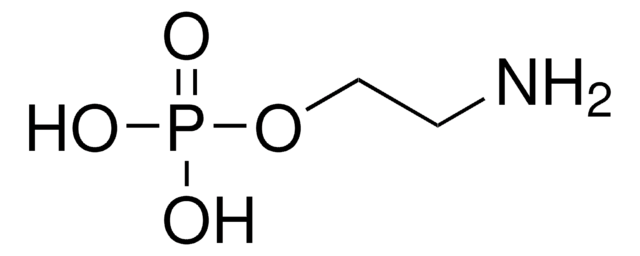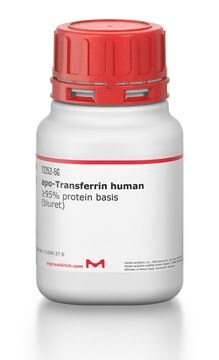E0135
Ethanolamine
liquid, BioReagent, suitable for cell culture, ≥98%
Synonym(s):
2-Aminoethanol, 2-Aminoethyl alcohol, ETA, MEA, MEA 90, MEA-LCI, Monoethanolamine
About This Item
Recommended Products
vapor density
2.1 (vs air)
Quality Level
vapor pressure
0.2 mmHg ( 20 °C)
product line
BioReagent
assay
≥98%
form
liquid
autoignition temp.
1436 °F
expl. lim.
17 %
concentration
16.6 M
technique(s)
cell culture | mammalian: suitable
refractive index
n20/D 1.454 (lit.)
pKa (25 °C)
9.5(lit.)
bp
170 °C (lit.)
69-70 °C/10 mmHg
mp
10-11 °C (lit.)
density
1.012 g/mL at 25 °C (lit.)
SMILES string
NCCO
InChI
1S/C2H7NO/c3-1-2-4/h4H,1-3H2
InChI key
HZAXFHJVJLSVMW-UHFFFAOYSA-N
Looking for similar products? Visit Product Comparison Guide
Related Categories
Application
signalword
Danger
Hazard Classifications
Acute Tox. 4 Dermal - Acute Tox. 4 Inhalation - Acute Tox. 4 Oral - Aquatic Chronic 3 - Eye Dam. 1 - Skin Corr. 1B - STOT SE 3
target_organs
Respiratory system
Storage Class
8A - Combustible corrosive hazardous materials
wgk_germany
WGK 2
flash_point_f
195.8 °F - Pensky-Martens closed cup
flash_point_c
91 °C - Pensky-Martens closed cup
ppe
Faceshields, Gloves, Goggles, type ABEK (EN14387) respirator filter
Choose from one of the most recent versions:
Already Own This Product?
Find documentation for the products that you have recently purchased in the Document Library.
Customers Also Viewed
Our team of scientists has experience in all areas of research including Life Science, Material Science, Chemical Synthesis, Chromatography, Analytical and many others.
Contact Technical Service












